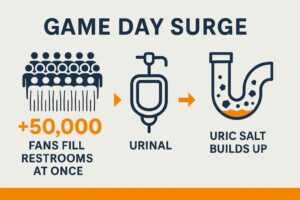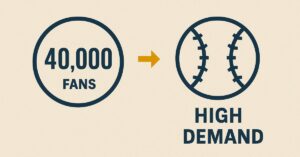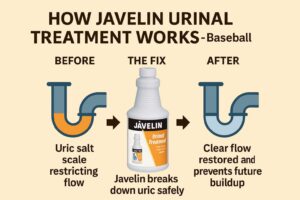Inside Baseball Stadium Restrooms: Why Urinals Clog and How to Stop It for Good

If you’ve ever managed a stadium facility, you already know what happens when 40,000 fans hit the restrooms at once. The lines move fast, the water doesn’t, and before the seventh inning, a urinal starts backing up somewhere under the concourse.
It’s not bad luck — it’s buildup. Uric salts, hard water, and constant surges create a perfect storm that chokes flow, kills odor control, and keeps maintenance crews playing catch-up.
Why Baseball Stadium Urinals Clog Faster Than Anywhere Else
Baseball stadiums have a unique rhythm. Long games, long breaks, and thousands of people moving at once. During a doubleheader at Yankee Stadium, restroom usage can spike 400% in minutes. By the time you’ve handled one section, another’s already slowing down.
Cities like Phoenix, Dallas, and Chicago add another layer hard water. Calcium and magnesium mix with uric acid and harden inside P-traps, leaving behind a rock-solid crust. Crews snake it, vacuum it, flush it, but the clogs always come back. Unless you actually dissolve that salt, you’re just treating the symptom.
Stadium Spotlights: East, Central, and West
 East Coast: Older parks like Fenway Park, Yankee Stadium, and Camden Yards have one thing in common aging lines. The water’s heavy, the fixtures are older, and the odor calls come in fast. Facility teams here know it’s not about reaction. It’s about prevention.
East Coast: Older parks like Fenway Park, Yankee Stadium, and Camden Yards have one thing in common aging lines. The water’s heavy, the fixtures are older, and the odor calls come in fast. Facility teams here know it’s not about reaction. It’s about prevention.
Central: In Wrigley Field, Busch Stadium, and Kauffman Stadium, winter off-seasons turn slow water into hard scale. When spring training hits, flow issues show up right out of the gate. It’s the same story at Progressive Field clear it, flush it, and watch it clog again by the next homestand.
West Coast: Dodger Stadium, Chase Field, T-Mobile Park, and Petco Park get the worst of the heat. High evaporation leaves uric salts behind like concrete. When fans smell it, it’s too late — the damage is already in the trap.

The Reality for Facility Crews
If you run maintenance in a ballpark, you’re short-staffed, short on time, and juggling everything from kitchens to locker rooms. A clogged urinal shouldn’t be an emergency, but when it happens mid-game, you’re on the radio before you can even clock out for lunch.
You don’t have the luxury of calling a plumber every time a section floods. You need something you can rely on fast, safe, and proven to work.
That’s where Javelin Urinal Treatment comes in. It’s the same solution plumbers use (and charge $200 for), but sold direct so your crew can handle it in-house. Stadiums, airports, and arenas across the country already use it to dissolve uric scale and keep pipes open, without harsh acids or downtime.

How Javelin Works
Javelin breaks down uric acid and mineral scale at the source. It doesn’t mask odor, it removes the cause. Once it hits the line, it softens buildup, dissolves the salt, and restores full flow in minutes. Safe for copper, PVC, and cast iron no corrosion, no damage, no need to pull fixtures off the wall.
A Simple Stadium Maintenance Routine
- Apply after games or overnight.
- Let it sit — give it time to work through uric scale.
- Flush and test flow.
- Repeat weekly during the season, biweekly in the off-season.
- Track the problem areas — adjust frequency where fans hit hardest.
Why Facility Managers Stick with It
- Same chemical plumbers use for a fraction of the price.
- Trusted in professional stadiums and major airports.
- Reduces emergency calls and weekend overtime.
- Eliminates odor by clearing the salt not covering it.
- Works fast, no equipment needed. If you can turn your wrist halfway, you can use Javelin.
Frequently Asked Questions
Why do stadium urinals clog so often?
Because of heavy traffic and hard water. When 30,000–50,000 fans use the same restrooms over a few hours, uric salts crystalize faster than routine cleaning can keep up.
Can I use Javelin during the season?
Yes. Crews apply it after games or between events it’s quick, safe, and doesn’t disrupt operations.
Does it really replace a plumber?
In many cases, yes. It’s the same solution professionals use you’re just skipping the $200 bill and handling it in-house.
Is it safe for older stadium plumbing?
Completely. It’s designed for all pipe types PVC, copper, or cast iron with no corrosion or acid burn.
How long does it take to work?
Usually 15–30 minutes per application. Tough buildup might need two cycles, but once cleared, flow stays consistent.
What’s the right maintenance schedule?
Weekly during peak season, biweekly or monthly off-season. Adjust for your water hardness and fan volume.
Who else uses Javelin?
It’s in use across stadiums, arenas, and airports nationwide anywhere heavy traffic creates slow, stinking urinals that crews can’t babysit daily.
Fix It Before the Next Home Game
Stadium maintenance teams from Wrigley to Dodger Stadium rely on Javelin Urinal Treatment to keep pipes clear, odors gone, and fans happy. Stop paying for the same problem every season fix it before the next home game.
